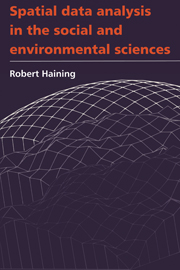Book contents
- Frontmatter
- Contents
- List of tables and displays
- Preface
- Acknowledgements
- PART A Introduction to issues in the analysis of spatially referenced data
- 1 Introduction
- 2 Issues in analysing spatial data
- PART B Parametric models for spatial variation
- PART C Spatial data collection and preliminary analysis
- PART D Modelling spatial data
- Postscript
- Glossary
- References
- Index
1 - Introduction
Published online by Cambridge University Press: 05 August 2012
- Frontmatter
- Contents
- List of tables and displays
- Preface
- Acknowledgements
- PART A Introduction to issues in the analysis of spatially referenced data
- 1 Introduction
- 2 Issues in analysing spatial data
- PART B Parametric models for spatial variation
- PART C Spatial data collection and preliminary analysis
- PART D Modelling spatial data
- Postscript
- Glossary
- References
- Index
Summary
A spatial data set consists of a collection of measurements or observations on one or more attributes taken at specified locations. Data sites are referenced so that the relative positions of sites are recorded, for the spatial organisation of the data is important whether the purpose of data analysis is to build a model for the data or to assess the relative merits of different hypotheses concerning some arrangement property of the data or some other (non spatial) characteristic of the data.
The principal purpose of this book is to describe and evaluate methods for spatial data analysis in order to show what is available, how the different techniques relate to one another and what can be achieved – in short, to contribute to the development of a sound inductive methodology for research areas that deal with data in their spatial context. In doing so, the book is aimed primarily at the social and environmental sciences and most of the examples are drawn from those areas. Apart from the fact that there are important links between social and environmental systems so that the study of one may draw in theory and data from the other, there are two other reasons for a methodological book that takes in both areas of research. First, both deal with observational rather than experimental data.
- Type
- Chapter
- Information
- Publisher: Cambridge University PressPrint publication year: 1990
- 1
- Cited by

